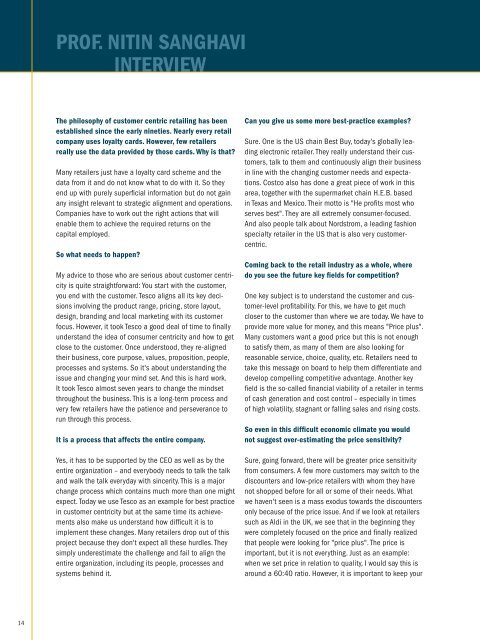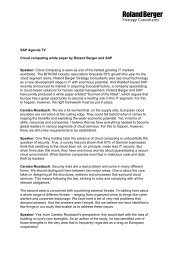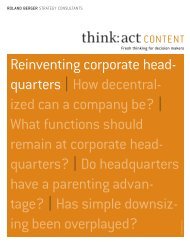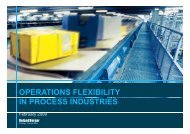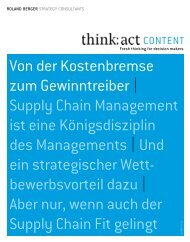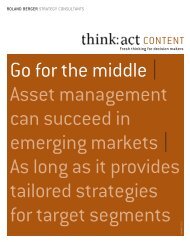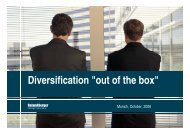Customer-centric retailing â Now you know what ... - Roland Berger
Customer-centric retailing â Now you know what ... - Roland Berger
Customer-centric retailing â Now you know what ... - Roland Berger
You also want an ePaper? Increase the reach of your titles
YUMPU automatically turns print PDFs into web optimized ePapers that Google loves.
PROF. NITIN SANGHAVIINTERVIEWThe philosophy of customer <strong>centric</strong> <strong>retailing</strong> has beenestablished since the early nineties. Nearly every retailcompany uses loyalty cards. However, few retailersreally use the data provided by those cards. Why is that?Many retailers just have a loyalty card scheme and thedata from it and do not <strong>know</strong> <strong>what</strong> to do with it. So theyend up with purely superficial information but do not gainany insight relevant to strategic alignment and operations.Companies have to work out the right actions that willenable them to achieve the required returns on thecapital employed.So <strong>what</strong> needs to happen?My advice to those who are serious about customer <strong>centric</strong>ityis quite straightforward: You start with the customer,<strong>you</strong> end with the customer. Tesco aligns all its key decisionsinvolving the product range, pricing, store la<strong>you</strong>t,design, branding and local marketing with its customerfocus. However, it took Tesco a good deal of time to finallyunderstand the idea of consumer <strong>centric</strong>ity and how to getclose to the customer. Once understood, they re-alignedtheir business, core purpose, values, proposition, people,processes and systems. So it's about understanding theissue and changing <strong>you</strong>r mind set. And this is hard work.It took Tesco almost seven years to change the mindsetthroughout the business. This is a long-term process andvery few retailers have the patience and perseverance torun through this process.It is a process that affects the entire company.Yes, it has to be supported by the CEO as well as by theentire organization – and everybody needs to talk the talkand walk the talk everyday with sincerity. This is a majorchange process which contains much more than one mightexpect. Today we use Tesco as an example for best practicein customer <strong>centric</strong>ity but at the same time its achievementsalso make us understand how difficult it is toimplement these changes. Many retailers drop out of thisproject because they don't expect all these hurdles. Theysimply underestimate the challenge and fail to align theentire organization, including its people, processes andsystems behind it.Can <strong>you</strong> give us some more best-practice examples?Sure. One is the US chain Best Buy, today's globally leadingelectronic retailer. They really understand their customers,talk to them and continuously align their businessin line with the changing customer needs and expectations.Costco also has done a great piece of work in thisarea, together with the supermarket chain H.E.B. basedin Texas and Mexico. Their motto is "He profits most whoserves best". They are all extremely consumer-focused.And also people talk about Nordstrom, a leading fashionspecialty retailer in the US that is also very customer<strong>centric</strong>.Coming back to the retail industry as a whole, wheredo <strong>you</strong> see the future key fields for competition?One key subject is to understand the customer and customer-levelprofitability. For this, we have to get muchcloser to the customer than where we are today. We have toprovide more value for money, and this means "Price plus".Many customers want a good price but this is not enoughto satisfy them, as many of them are also looking forreasonable service, choice, quality, etc. Retailers need totake this message on board to help them differentiate anddevelop compelling competitive advantage. Another keyfield is the so-called financial viability of a retailer in termsof cash generation and cost control – especially in timesof high volatility, stagnant or falling sales and rising costs.So even in this difficult economic climate <strong>you</strong> wouldnot suggest over-estimating the price sensitivity?Sure, going forward, there will be greater price sensitivityfrom consumers. A few more customers may switch to thediscounters and low-price retailers with whom they havenot shopped before for all or some of their needs. Whatwe haven't seen is a mass exodus towards the discountersonly because of the price issue. And if we look at retailerssuch as Aldi in the UK, we see that in the beginning theywere completely focused on the price and finally realizedthat people were looking for "price plus". The price isimportant, but it is not everything. Just as an example:when we set price in relation to quality, I would say this isaround a 60:40 ratio. However, it is important to keep <strong>you</strong>r14


